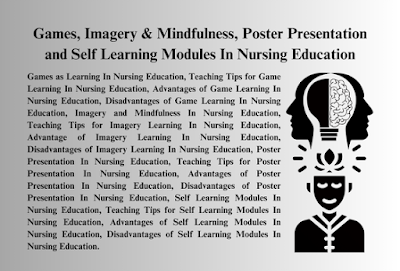Games as Pedagogical Tools in Nursing Education
Educational games constitute structured activities with defined rules that test participants’ knowledge or competencies in pursuit of specific learning objectives. These can be executed either online or in-person and are particularly effective for facilitating interprofessional “ice breaker” exercises. Various gaming applications are accessible for online engagement.
Strategies for Implementing Game-Based Learning in Nursing Education
Employ games primarily for the reinforcement of existing knowledge rather than for the introduction of novel concepts. An open learning environment is vital for successful game-based learning. Educators should adopt a background role, allowing peer-to-peer interaction to drive learning outcomes.
Post-game debriefing is crucial to ensure students can draw clear connections between the game experience and essential educational concepts. Educators who lack appreciation for gaming as a pedagogical tool may unintentionally undermine its effectiveness.
Advantages of Game-Based Learning in Nursing Education
Gaming promotes increased student engagement and enhances both cognitive and emotional learning. It improves knowledge retention, adds an element of enjoyment, fosters learner involvement, and serves to link theoretical knowledge with practical application. The experiential nature of games allows students to learn from each other, which is particularly beneficial for adult learners who take greater responsibility for their learning journey. Furthermore, games offer immediate feedback and demonstrate the practical application of theoretical concepts, often resulting in more enduring learning compared to traditional lectures.
Disadvantages of Game-Based Learning in Nursing Education
Some students may find games intimidating if they are unsure of the answers, and game-based learning can be time-consuming and potentially costly to develop or acquire. Assessing the depth of learning achieved through gaming can be challenging, especially with multiple participants involved. Additionally, games might require substantial space and necessitate introductory and summary sessions to ensure educational objectives are met, with faculty setting clear guidelines to maintain educational value.
Imagery and Mindfulness in Nursing Education
Imagery and mindfulness involve mental visualization or simulation of scenarios prior to practical application. These techniques are most effective when combined with other strategies, such as physical practice in psychomotor skill acquisition.
Strategies for Teaching Imagery Techniques in Nursing Education
Develop scenarios that replicate real-life situations to illustrate effective use of imagery. Incorporating relaxation techniques can serve as a practical example of imagery application. A supportive classroom environment is essential for the effective implementation of these strategies, which can also aid in stress reduction and have practical implications for nursing practice.
Advantages of Imagery Learning in Nursing Education
Imagery and mindfulness techniques significantly enhance the learning of psychomotor skills when integrated with physical practice. These methods can facilitate the development of therapeutic and holistic nursing skills.
Disadvantages of Imagery Learning in Nursing Education
Variability in individuals’ innate imagery skills means some students may require additional instruction to effectively utilize these techniques. Imagery alone cannot substitute for physical practice of skills, and combining imagery with physical practice may demand more study time. Stress and performance anxiety might interfere with the effective use of imagery, and faculty development may be necessary to successfully implement this strategy.
Poster Presentations in Nursing Education
A poster serves as a visual representation of learning outcomes and can be developed online. This format is well-suited for peer or interprofessional learning and offers opportunities for knowledge dissemination.
Strategies for Teaching Poster Presentation in Nursing Education
Provide clear instructions on poster design and establish guidelines for content and evaluation. Incorporating artistic elements can enhance poster quality, and various software tools are available to assist in creating visually appealing presentations.
Advantages of Poster Presentations in Nursing Education
Posters allow students to convey complex concepts and foster creativity. They also serve as a medium for showcasing student knowledge and receiving feedback from peers and faculty. The skills acquired through poster creation can be valuable in professional settings and can be showcased at conferences or student exhibitions. Evaluation of posters can be efficiently carried out using established guidelines or rubrics.
Disadvantages of Poster Presentations in Nursing Education
Developing a poster assignment and corresponding evaluation methods can be time-consuming for faculty. Students who are not visual learners might find this method challenging. See Briggs (2009), Christenbery and Latham (2012), and Sterman et al. (2013) for additional insights.
Self-Learning Modules in Nursing Education
Self-learning modules provide focused content on specific objectives, allowing students to skip sections they have already mastered. These modules often include self-assessments (pretests and posttests) and are ideal for pre-class assignments in flipped classrooms.
Strategies for Teaching Self-Learning Modules in Nursing Education
Self-learning modules can be utilized for single class periods, entire courses, enrichment, or remedial learning. They can be created online and used in blended learning formats, with students completing modules in preparation for in-class objectives.
Advantages of Self-Learning Modules in Nursing Education
Modules are particularly advantageous for adult learners with limited study time, offering flexibility regarding when and where learning occurs. They enable learning without direct teacher presence and are effective for teaching psychomotor skills, often surpassing traditional lecture and discussion methods. This approach is particularly effective for intrinsically motivated students.
Disadvantages of Self-Learning Modules in Nursing Education
Students may procrastinate, leading to untimely completion of work. Additionally, developing and updating modules can be resource-intensive for faculty.
